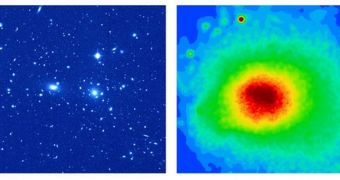In a recent series of studies, astrophysicists decided to test the theory of “hidden matter” yet again, this time against a more well-known cosmic structure. They looked at the Coma cluster of galaxies, and determined that there simply isn't enough mass in it to account for its gravitational pull.
This cosmic structure (also known among experts as Abell 1656) is one of the two main components of the Coma Supercluster. The other component is Abell 1367, nicknamed the Leo Cluster.
Extending more than 1.37 billion light years in length, and featuring an estimated 10,000 galaxies, maybe even more, the object is located some 321 million light-years from Earth, which is relatively close in astronomical terms.
The first image in the composite view attached to this article shows a narrow region at the center of the cluster, as it was recently seen by the Palomar Sky Survey. The endeavor, carried out by ground-based telescopes at the California Institute of Technology (Caltech), observes the sky in visible light.
The second image, to the right, shows the same area in X-ray wavelengths, as it was viewed by the Einstein satellite. Scientists superimposed the two viewed, in order to determine how the cluster exerts its massive gravitational pull.
They were able to discover that the weight of the Coma cluster was simply insufficient to account for the amount of pull it exerted on its surroundings. Albert Einstein's theory of general relativity shows that gravity is entirely dependent on mass.
According to theory, the phenomenon is not clearly visible for small objects, but becomes obvious for moons, planets, star systems, galaxies and superclusters. As far as the Coma cluster goes, it simply does not have enough mass to explain why it has so much gravity.
In order to keep the massive structure cohesive, its individual components would need to be significantly heavier. Scientists say that the difference between the real and expected mass are massive.
Astrophysicists say that this discovery bears a significant implication, and namely that dark matter can be made of both baryonic and non-baryonic material. This form of matter is believed to be responsible for supplementing the differences between visible and required matter.
Dark matter does not interact with regular matter directly, but rather through the force of gravity. If the Coma cluster contains massive amounts of the stuff, then this would go a long way towards explaining the gravitational pull keeping the cluster in one piece, Daily Galaxy reports.

 14 DAY TRIAL //
14 DAY TRIAL //